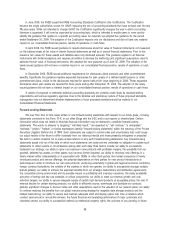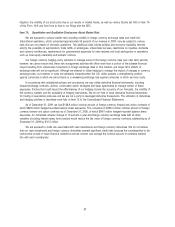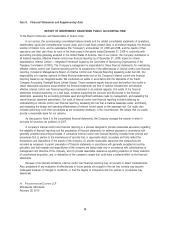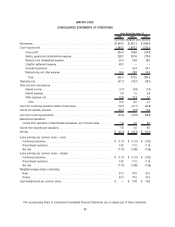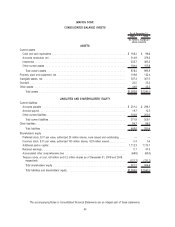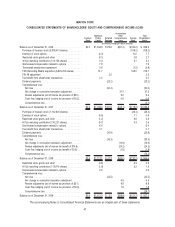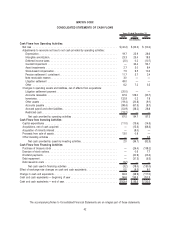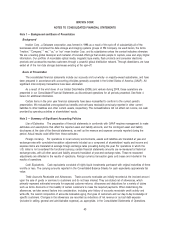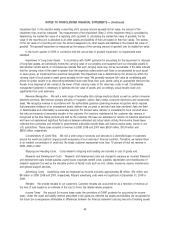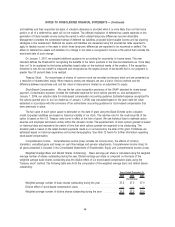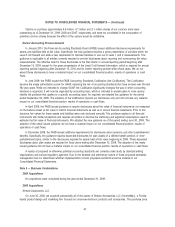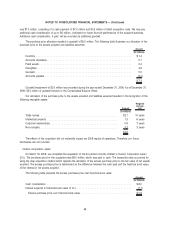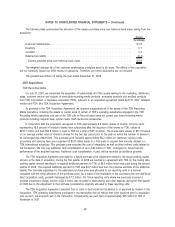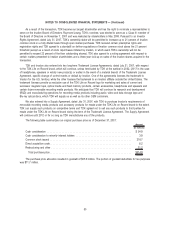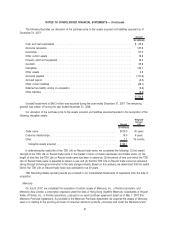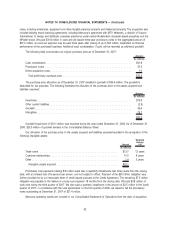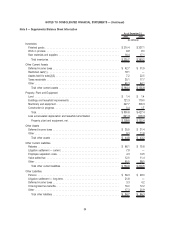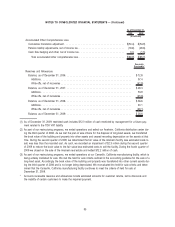Memorex 2009 Annual Report Download - page 53
Download and view the complete annual report
Please find page 53 of the 2009 Memorex annual report below. You can navigate through the pages in the report by either clicking on the pages listed below, or by using the keyword search tool below to find specific information within the annual report.
and liabilities and their respective tax basis. A valuation allowance is provided when it is more likely than not that some
portion or all of a deferred tax asset will not be realized. The ultimate realization of deferred tax assets depends on the
generation of future taxable income during the period in which related temporary differences become deductible.
Management considers the scheduled reversal of deferred tax liabilities, projected future taxable income and tax planning
strategies in this assessment. Deferred tax assets and liabilities are measured using the enacted tax rates expected to
apply to taxable income in the years in which those temporary differences are expected to be recovered or settled. The
effect on deferred tax assets and liabilities of a change in tax rates is recognized in income in the period that includes the
enactment date of such change.
On January 1, 2007, we adopted additional guidance for accounting for uncertainty in income taxes. This new
standard defines the threshold for recognizing the benefits of tax return positions in the financial statements as “more likely
than not” to be sustained by the taxing authorities based solely on the technical merits of the position. If the recognition
threshold is met, the tax benefit is measured and recognized as the largest amount of tax benefit that in our judgment is
greater than 50 percent likely to be realized.
Treasury Stock. Our repurchases of shares of common stock are recorded as treasury stock and are presented as
a reduction of shareholders’ equity. When treasury shares are reissued, we use a last-in, first-out method and the
difference between repurchase cost and fair value at reissuance is treated as an adjustment to equity.
Stock-Based Compensation. We use the fair value recognition provisions of the GAAP standard for share-based
payment. Compensation expense includes the estimated expense for stock options granted on, and subsequent to,
January 1, 2006, our adoption date for stock-based compensation accounting guidance. Estimated expense recognized for
the options granted prior to, but not vested as of January 1, 2006, was calculated based on the grant date fair value
estimated in accordance with the provisions of the authoritative accounting guidance for stock-based compensation that
were previously in place.
The fair value of each option award is estimated on the date of grant using the Black-Scholes option valuation
model. Expected volatilities are based on historical volatility of our stock. The risk-free rate for the contractual life of the
option is based on the U.S. Treasury yield curve in effect at the time of grant. We use historical data to estimate option
exercise and employee termination activity within the valuation model. The expected term of stock options granted is based
on historical data and represents the period of time that stock options granted are expected to be outstanding. The
dividend yield is based on the latest dividend payments made on or announced by the date of the grant. Forfeitures are
estimated based on historical experience and current demographics. See Note 12 herein for further information regarding
stock-based compensation.
Comprehensive Income. Comprehensive income (loss) includes net income (loss), the effects of currency
translation, unrealized gains and losses on cash flow hedges and pension adjustments. Comprehensive income (loss) for
all years presented is included in the Consolidated Statements of Shareholders’ Equity and Comprehensive Income (Loss).
Weighted Average Basic and Diluted Shares Outstanding. Basic earnings per share is calculated using the weighted
average number of shares outstanding during the year. Diluted earnings per share is computed on the basis of the
weighted average basic shares outstanding plus the dilutive effect of our stock-based compensation plans using the
“treasury stock” method. The following table sets forth the computation of the weighted average basic and diluted shares
outstanding:
2009 2008 2007
Years Ended December 31,
(In millions)
Weighted average number of basic shares outstanding during the year . . . . . . . . . . . 37.5 37.5 37.0
Dilutive effect of stock-based compensation plans . . . . . . . . . . . . . . . . . . . . . . . . . . — — —
Weighted average number of dilutive shares outstanding during the year . . . . . . . . . . 37.5 37.5 37.0
46
NOTES TO CONSOLIDATED FINANCIAL STATEMENTS — (Continued)


